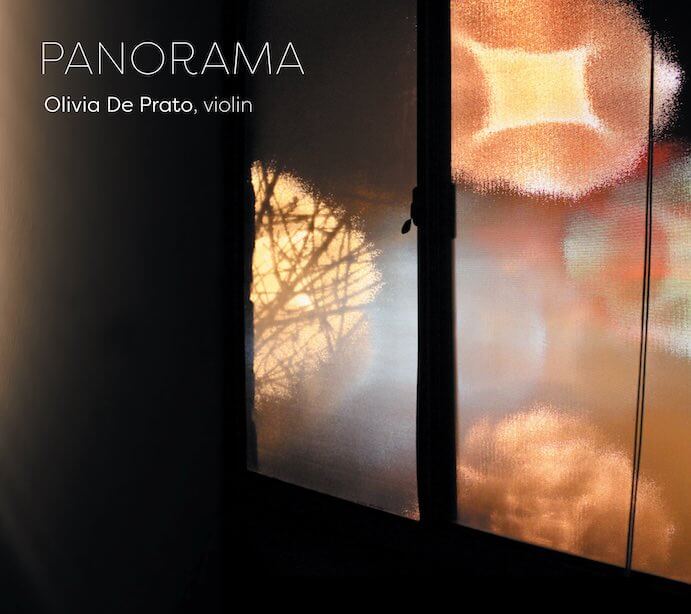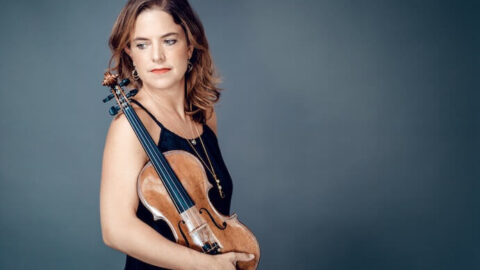Home, identity, and self are ideas that apply to everyone navigating their way through life; each story is unique and fluid as time passes. These themes are the inspiration for the works featured on violinist Olivia De Prato‘s latest album, Panorama, released April 14 on New Focus Recordings. The album’s five compositions mindfully explore the intimate details and diverse interpretations of these guiding concepts. From direct applications to wonderfully poetic interpretations, De Prato’s natural musicality and care create a successful collaborative narrative with each composer.
In Missy Mazzoli‘s Tooth and Nail, driving electronic pulsations, quickly panning back and forth, immediately provide an immersive, spinning environment. The undulating overtones of the steady electronic rhythm evokes the sounds of the mouth harp, an instrument symbolizing commonality across cultures owing to its broad international history. De Prato gracefully transitions between Mazzoli’s aggressive rhythmic motifs and folkloric arpeggios as the electronics drift between steady rhythmic patterns and chorale-like passages. These shifting forms expand rapidly at times, but Mazzoli’s astutely anchors the piece with an unassuming glissando that passes between violin and electronics over the full duration. Intense, powerful, and spiritual, De Prato’s delicate precision in seamlessly floating above the electronic texture sets an impressive tone.

There is deep complexity in the warmth and sorrow brought forth by De Prato in the first four notes of Jen Shyu‘s Jeom Jaeng Yi (Fortune Teller), which embodies De Prato’s thoughts in the liner notes — that “time is the medium of all human life.” The work is a conversation about life and time, a deep reflection born from Shyu’s meditation on the tragically short life of writer, filmmaker, and performance artist Theresa Hak Kyung Cha. The hauntingly poetic work sets an excerpt from Cha’s novel Dictee, creating a beautiful sense of reverence. The violin melody is scored in rhythmic unison with the spoken text, and as the two meld, the words take on an ethereal disembodiment, as if synthesized and illuminated beyond Cha’s text, into a powerful homage to her life.
Angélica Negrón‘s Panorama approaches home and identity from her experiences traveling between Puerto Rico and New York. Throughout, the electronics oscillate between atmospheric harmonies and consistent, pinging rhythms in a clear reference to the two places she calls home. There is a tremendous yearning in De Prato’s reading of the uncertain but hopeful work. A simple, yet soaring melodic line lets De Prato ponder how each individual tone fits into the expansive chordal textures from the electronics. The bold starkness and pacing of the melodies require an understanding beyond technical prowess, and De Prato delves deep into the work to bring out its identity.
Listening to Miya Masaoka‘s Mapping a Joyful Path is like entering into a world of wonderfully subtle intricacies and nuances; every listening brings new sounds and beating patterns to life, yet it feels impossible to take it all in at once. Time seems to float, and while the music feels unsettled at times, there is also a sense of accepting that the journey to find one’s home and identity is fluid and never-ending. Every moment is fragile; a single violin note may begin resolutely, yet slowly lose its stability as the electronics waver to reveal lush beating patterns. Mapping a Joyful Path requires the listener’s openness and intention to experience every moment, and De Prato exemplifies those very qualities in her performance, carefully emphasizing each exceptional tone and texture.
The final work, Balconies, by Samantha Fernando, asks us to consider distance and perspective; what do we hear when we focus closely on details, in contrast to stepping back and listening to the whole? The multi-track violin work creates a cohesive, singular sound dimension, as if “viewing” the work from afar, while the use of jagged, scratchy, and overpressured textural complexities reveal gritty details. De Prato’s intuitive sense keeps her inside the electronic texture, now and again breaking free, which adds depth to the piece’s concept.
On Panorama, De Prato successfully finds the most vulnerable aspects of each work to create a much larger portrait of being human. Some of the composers celebrate their cultural identity while others highlight larger commonalities. De Prato’s curation of the album creates a panoramic view of coexistence, weaving multiple viewpoints into a cohesive throughline while identifying what is genuinely embedded inside each work.
I CARE IF YOU LISTEN is an editorially-independent program of the American Composers Forum, and is made possible thanks to generous donor and institutional support. Opinions expressed are solely those of the author and may not represent the views of ICIYL or ACF.
You can support the work of ICIYL with a tax-deductible gift to ACF. For more on ACF, visit the “At ACF” section or composersforum.org.
























